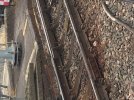Yes, it would have been jointed bull-head rail in those days. Must have made a tremendous din travelling over it at 126mph and I dare say a few keys probably popped out as well! AFAIK - and I'm sure our more knowledgeable P. Way friends will correct me if I'm wrong - flat bottom rail was first installed experimentally in the UK in the inter-war period by the LMS and LNER, although still in jointed 60 foot lengths. It wasn't widely adopted until after nationalisation in 1948 and continuously welded rail didn't become widespread until the late 1950's on main lines and much later on secondary routes. Although most CWR was flat-bottom laid on concrete sleepers, bull-head CWR on wooden sleepers was widely used on secondary main lines in the former North Eastern Region such as York-Scarborough and the Durham Coast line. These rails were produced in a special rail welding depot set up at Dinsdale, near Darlington. I remember, when I worked at Aylesbury in the early 'nineties, there were two sections of continuously-welded bull-head rail with concrete sleepers on the Risborough branch, either side of Little Kimble. I believe that the maximum permitted speed on jointed track nowadays is 75 mph and 60 if it's bull-head rail but, again, I'm open to correction. When I was at Brighton in the mid-eighties there was still a roughly half-mile section of jointed bull-head rail on the Up Eastbourne line between Polegate and Berwick which had a theoretical 90 mph limit but, as all passenger trains stopped at Polegate and it was on a fairly steep rising gradient, it was rarely traversed at more than about 70, even by the expresses which didn't stop at Berwick. I also recall that, well into the new century, there was a fairly long section of 90 mph jointed flat-bottom rail on the Down WoE line between Grateley and Salisbury and that made a really impressive sound at full-pelt going downhill.

